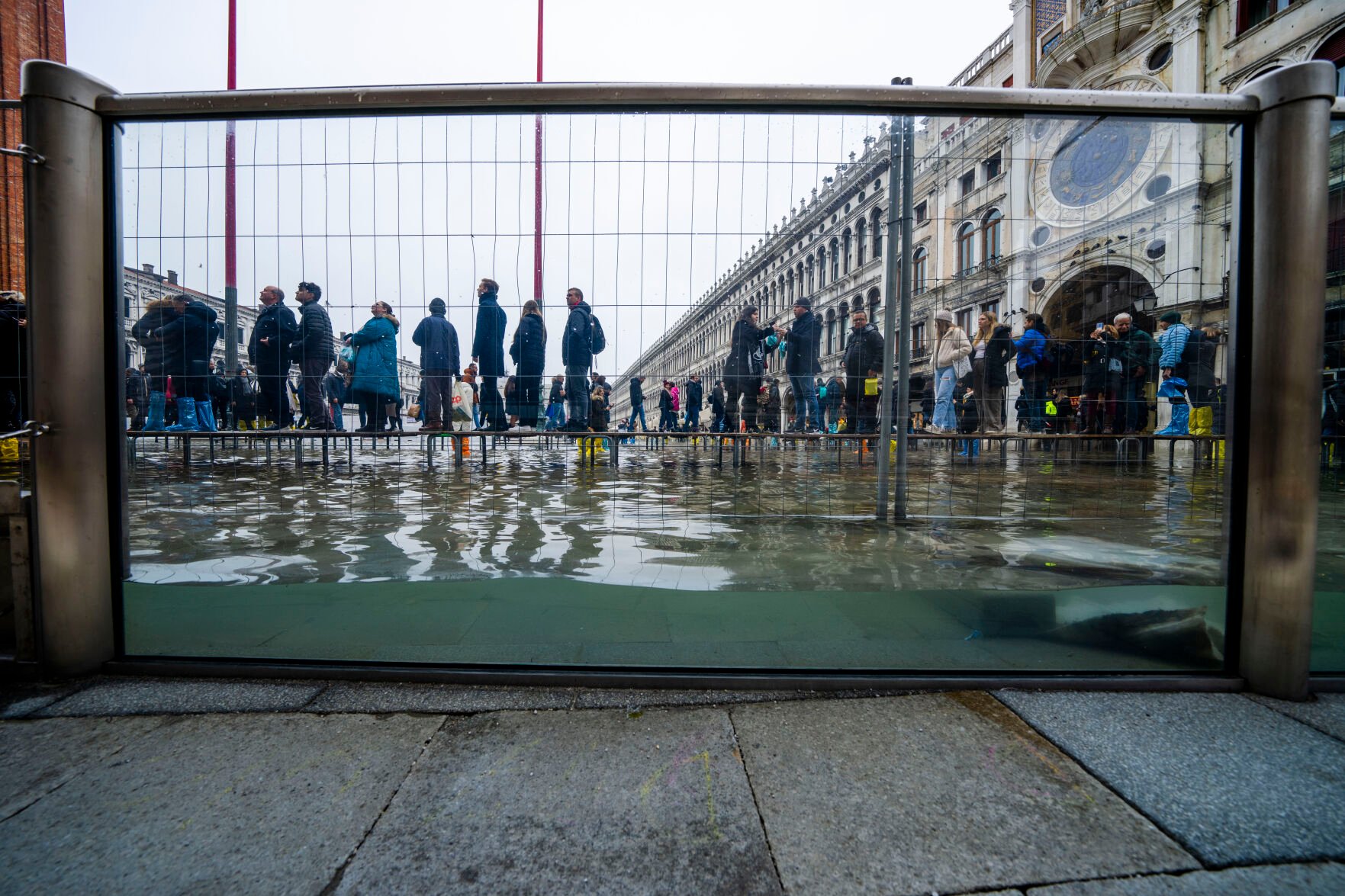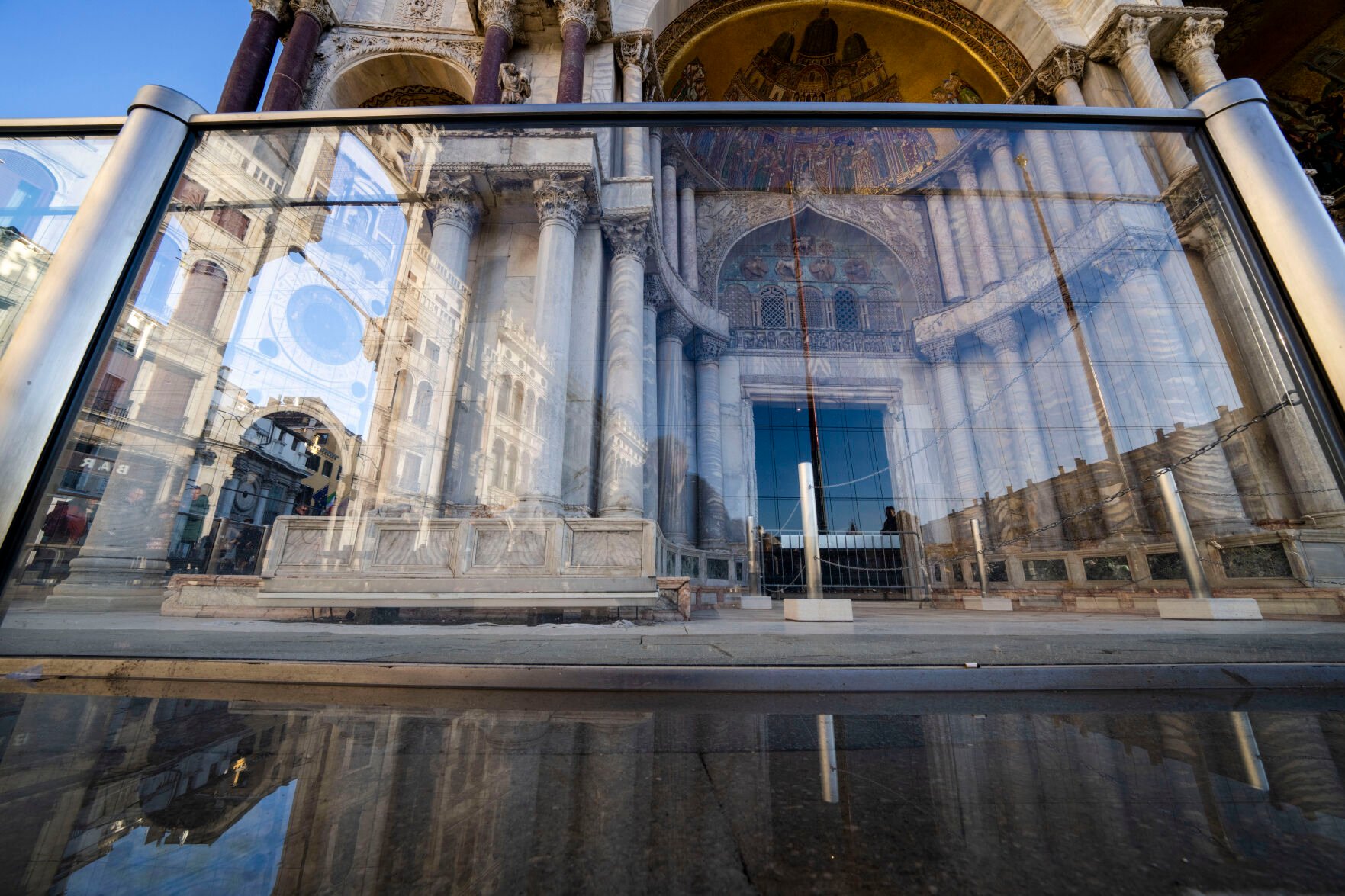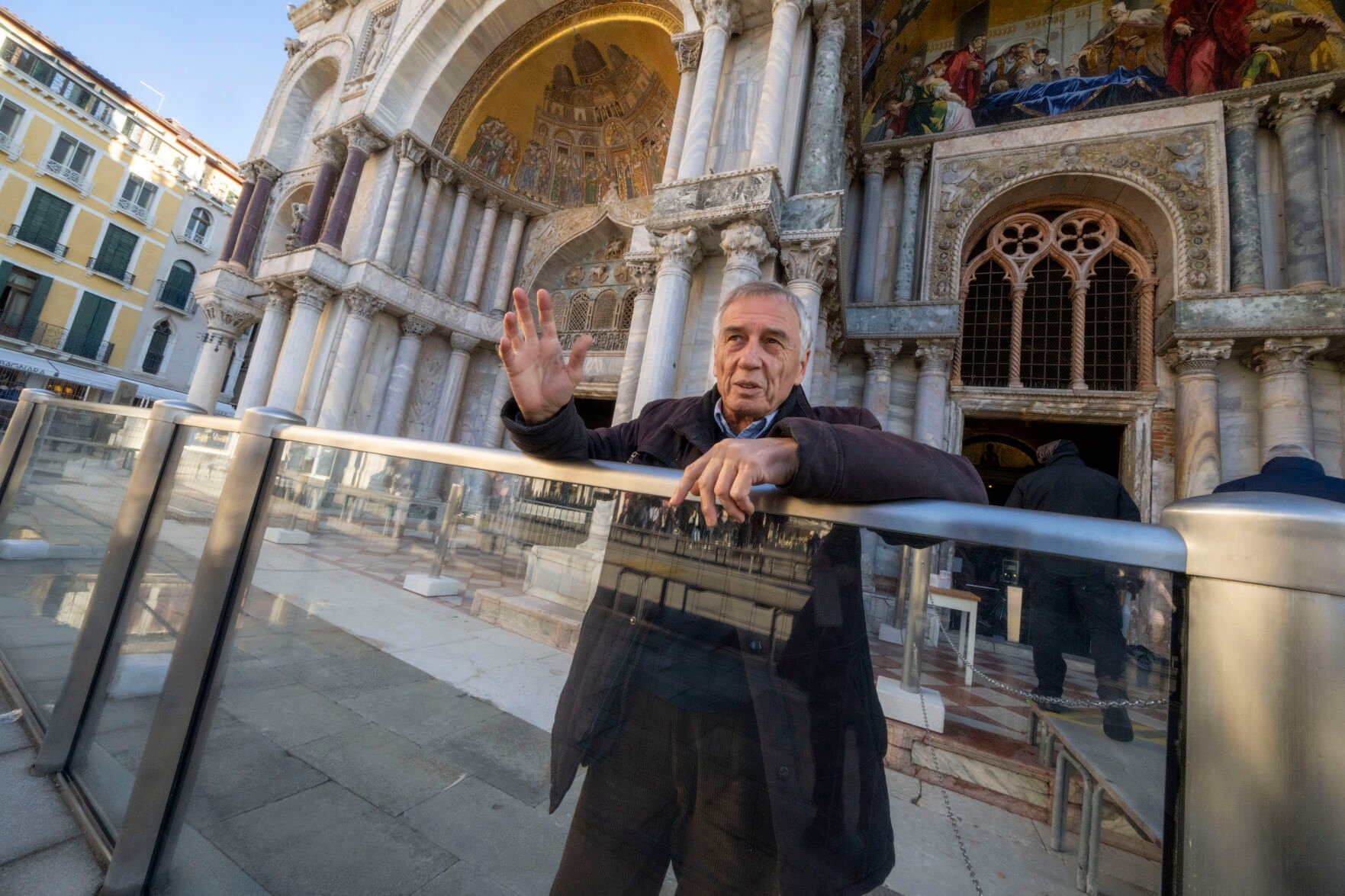VENICE, Italy — It’s a simple solution, but one that may keep the marble columns and valuable mosaics of Venice’s iconic St. Mark’s Basilica safe from seawater-induced erosion: A set of glass barriers installed around the 900-year-old church has kept its floors dry during frequent high tides.

Domenico Stinellis, Associated Press
Tourists and residents walk on catwalks during a sea tide of around 38 inches to cross a flooded St. Mark's Square On Dec. 10 in Venice, Italy, where recently installed glass barriers prevent seawater from flooding the 900-year-old iconic St Mark's Basilica. St. Mark's Square is the lowest-laying city area and frequently ends up underwater during extreme weather.
Even after it evaporates, water leaves behind salt crystals that corrode the marble bases of the columns and the floor mosaics, said Mario Piana, the architect and restoration expert in charge of St. Mark’s.
The new barriers are made of glass mounted on a base of armored concrete that is buried below the pavement of the famous St Mark’s square to resist the force of surging water. Piana said the system could keep out up to 1.10 meters (3 feet, 6 inches) of water in the square, equivalent to a tide of 1.90 meters (6.2 feet) above sea level.

Domenico Stinellis, Associated Press
A thin layer of seawater surfaces during a moderately high tide on Dec. 7 in St. Mark's Square in Venice, Italy.
“Let’s hope that, from now on, there are no more high waters that will touch the base of the basilica,” the expert said during an on-site visit, stressing the fragility of the clay-brick structure.
Built on log piles among canals, the palatial city of Venice has grappled with flooding since its foundation 1,600 years ago. But like other coastal areas, rising sea levels and more extreme weather that scientists associate with climate change have meant more frequent high tides.
While the basilica was built on what was one of Venice’s highest points at the time, it now sits on one of the city’s lowest due to subsidence and rising sea levels.
As a result, St. Mark’s gets more flooding than most places and remains vulnerable despite the activation of the Moses underwater barriers around the lagoon city in 2020 to protect Venice from floods over 1.3 meters.

Domenico Stinellis, Associated Press
Procurator of St. Mark's Basilica Mario Piana leans on a glass tide barrier on Dec. 7 in St. Mark's Square in Venice, Italy.
Flooding in November 2019 was especially devastating because the water could not recede quickly following repeated deluges, leaving parts of the basilica submerged for up to 24 hours.
Floodwaters getting into the basilica have frequently been happening also out of season, too, making it all the more vulnerable and pushing officials to devise the new glass barriers as a defense.
Piana said that the glass and concrete barriers were part of a larger engineering project to set up a series of channels below the surface of the church and its namesake square to carry off water from the lagoon and keep it from flooding the square.
-
Glass barriers keep Venice’s iconic basilica dry
Domenico Stinellis - staff, AP
Signs of erosion are visible inside St. Mark's Basilica in Venice, northern Italy, Wednesday, Dec. 7, 2022. Glass barriers that prevent seawater from flooding the 900-year-old iconic Venice's Basilica during high tides have been recently installed in St. Mark's Square which is the lowest-laying city area and frequently ends up underwater during extreme weather.
Domenico Stinellis - staff, AP
Signs of erosion are visible inside St. Mark's Basilica in Venice, northern Italy, Wednesday, Dec. 7, 2022. Glass barriers that prevent seawater from flooding the 900-year-old iconic Venice's Basilica during high tides have been recently installed in St. Mark's Square which is the lowest-laying city area and frequently ends up underwater during extreme weather.
-
Glass barriers keep Venice’s iconic basilica dry
Domenico Stinellis, Associated Press
A couple stops on the fragile marble mosaics on the floor of St. Mark's Basilica on Dec. 7 in Venice, Italy.
Domenico Stinellis, Associated Press
A couple stops on the fragile marble mosaics on the floor of St. Mark's Basilica on Dec. 7 in Venice, Italy.
-
-
Glass barriers keep Venice’s iconic basilica dry
Domenico Stinellis - staff, AP
Tourists and residents walk on catwalks during a sea tide of around 97 centimeters (38.18 inches) to cross a flooded St. Mark's Square in Venice, northern Italy, Saturday, Dec. 10, 2022, where recently installed glass barriers prevent seawater from flooding the 900-year-old iconic St Mark's Basilica, left. St. Mark's Square is the lowest-laying city area and frequently ends up underwater during extreme weather.
Domenico Stinellis - staff, AP
Tourists and residents walk on catwalks during a sea tide of around 97 centimeters (38.18 inches) to cross a flooded St. Mark's Square in Venice, northern Italy, Saturday, Dec. 10, 2022, where recently installed glass barriers prevent seawater from flooding the 900-year-old iconic St Mark's Basilica, left. St. Mark's Square is the lowest-laying city area and frequently ends up underwater during extreme weather.
-
Glass barriers keep Venice’s iconic basilica dry
Domenico Stinellis, Associated Press
Signs of erosion are visible on Dec. 7 inside St. Mark's Basilica in Venice, Italy.
Domenico Stinellis, Associated Press
Signs of erosion are visible on Dec. 7 inside St. Mark's Basilica in Venice, Italy.
-
-
Glass barriers keep Venice’s iconic basilica dry
Domenico Stinellis, Associated Press
Seawater floods the floors of St. Mark's Basilica on Dec. 17, 2019, in Venice, Italy. Seawaters no longer endanger the marble mosaics of the floor after glass barriers that prevent seawater from flooding inside during high tide have been recently installed around the 900-year-old basilica.
Domenico Stinellis, Associated Press
Seawater floods the floors of St. Mark's Basilica on Dec. 17, 2019, in Venice, Italy. Seawaters no longer endanger the marble mosaics of the floor after glass barriers that prevent seawater from flooding inside during high tide have been recently installed around the 900-year-old basilica.
-
Glass barriers keep Venice’s iconic basilica dry
Domenico Stinellis, Associated Press
Belt barriers limit visitors' circulation on the fragile marble mosaics of the floor of St. Mark's Basilica on Dec. 7 in Venice, Italy.
Domenico Stinellis, Associated Press
Belt barriers limit visitors' circulation on the fragile marble mosaics of the floor of St. Mark's Basilica on Dec. 7 in Venice, Italy.
-
-
Glass barriers keep Venice’s iconic basilica dry
Domenico Stinellis, Associated Press
Procurator of St. Mark's Basilica Mario Piana leans on a glass tide barrier on Dec. 7 in St. Mark's Square in Venice, Italy.
Domenico Stinellis, Associated Press
Procurator of St. Mark's Basilica Mario Piana leans on a glass tide barrier on Dec. 7 in St. Mark's Square in Venice, Italy.
-
Glass barriers keep Venice’s iconic basilica dry
Domenico Stinellis - staff, AP
The sunlight filtering through one of the doors of St. Mark's Basilica casts patterns on the floor mosaics bleached by seawaters in Venice, northern Italy, Wednesday, Dec. 7, 2022. Glass barriers that prevent seawater from flooding the 900-year-old iconic Venice's Basilica have been recently installed around it. St. Mark's Square is the lowest-laying city area and frequently ends up underwater during extreme weather.
Domenico Stinellis - staff, AP
The sunlight filtering through one of the doors of St. Mark's Basilica casts patterns on the floor mosaics bleached by seawaters in Venice, northern Italy, Wednesday, Dec. 7, 2022. Glass barriers that prevent seawater from flooding the 900-year-old iconic Venice's Basilica have been recently installed around it. St. Mark's Square is the lowest-laying city area and frequently ends up underwater during extreme weather.
-
-
Glass barriers keep Venice’s iconic basilica dry
Domenico Stinellis - staff, AP
A visitor enters St. Mark's Basilica in Venice, northern Italy, Wednesday, Dec. 7, 2022, where seawaters no longer endanger the fragile marble mosaics of the floors after glass barriers that prevent seawater from flooding the 900-year-old iconic Venice's Basilica during high tides have been recently installed in St. Mark's Square that is the lowest-laying city area and frequently ends up underwater during extreme weather.
Domenico Stinellis - staff, AP
A visitor enters St. Mark's Basilica in Venice, northern Italy, Wednesday, Dec. 7, 2022, where seawaters no longer endanger the fragile marble mosaics of the floors after glass barriers that prevent seawater from flooding the 900-year-old iconic Venice's Basilica during high tides have been recently installed in St. Mark's Square that is the lowest-laying city area and frequently ends up underwater during extreme weather.
-
Glass barriers keep Venice’s iconic basilica dry
Domenico Stinellis - staff, AP
Signs of erosion are visible inside St. Mark's Basilica in Venice, northern Italy, Wednesday, Dec. 7, 2022. Glass barriers that prevent seawater from flooding the 900-year-old iconic Venice's Basilica during high tides have been recently installed in St. Mark's Square which is the lowest-laying city area and frequently ends up underwater during extreme weather.
Domenico Stinellis - staff, AP
Signs of erosion are visible inside St. Mark's Basilica in Venice, northern Italy, Wednesday, Dec. 7, 2022. Glass barriers that prevent seawater from flooding the 900-year-old iconic Venice's Basilica during high tides have been recently installed in St. Mark's Square which is the lowest-laying city area and frequently ends up underwater during extreme weather.
-
-
Glass barriers keep Venice’s iconic basilica dry
Domenico Stinellis - staff, AP
Signs of erosion are visible inside St. Mark's Basilica in Venice, northern Italy, Wednesday, Dec. 7, 2022. Glass barriers that prevent seawater from flooding the 900-year-old iconic Venice's Basilica during high tides have been recently installed in St. Mark's Square which is the lowest-laying city area and frequently ends up underwater during extreme weather.
Domenico Stinellis - staff, AP
Signs of erosion are visible inside St. Mark's Basilica in Venice, northern Italy, Wednesday, Dec. 7, 2022. Glass barriers that prevent seawater from flooding the 900-year-old iconic Venice's Basilica during high tides have been recently installed in St. Mark's Square which is the lowest-laying city area and frequently ends up underwater during extreme weather.
-
Glass barriers keep Venice’s iconic basilica dry
Domenico Stinellis - staff, AP
Belt barriers limit visitors' circulation on the fragile marble mosaics on the floor of St. Mark's Basilica endangered for centuries by seawaters in Venice, northern Italy, Wednesday, Dec. 7, 2022. Glass barriers that prevent seawater from flooding the 900-year-old iconic Venice's Basilica during high tides have been recently installed around it. St. Mark's Square is the lowest-laying city area and frequently ends up underwater during extreme weather.
Domenico Stinellis - staff, AP
Belt barriers limit visitors' circulation on the fragile marble mosaics on the floor of St. Mark's Basilica endangered for centuries by seawaters in Venice, northern Italy, Wednesday, Dec. 7, 2022. Glass barriers that prevent seawater from flooding the 900-year-old iconic Venice's Basilica during high tides have been recently installed around it. St. Mark's Square is the lowest-laying city area and frequently ends up underwater during extreme weather.
-
-
Glass barriers keep Venice’s iconic basilica dry
Domenico Stinellis - staff, AP
People walk on the fragile marble mosaics on the floor of St. Mark's Basilica in Venice, northern Italy, Wednesday, Dec. 7, 2022. Glass barriers that prevent seawater from flooding the 900-year-old iconic St Mark's Basilica during high tides have been recently installed around it. St. Mark's Square is the lowest-laying city area and frequently ends up underwater during extreme weather.
Domenico Stinellis - staff, AP
People walk on the fragile marble mosaics on the floor of St. Mark's Basilica in Venice, northern Italy, Wednesday, Dec. 7, 2022. Glass barriers that prevent seawater from flooding the 900-year-old iconic St Mark's Basilica during high tides have been recently installed around it. St. Mark's Square is the lowest-laying city area and frequently ends up underwater during extreme weather.
-
Glass barriers keep Venice’s iconic basilica dry
Domenico Stinellis, Associated Press
A thin layer of seawater surfaces during a moderately high tide on Dec. 7 in St. Mark's Square in Venice, Italy.
Domenico Stinellis, Associated Press
A thin layer of seawater surfaces during a moderately high tide on Dec. 7 in St. Mark's Square in Venice, Italy.
-
-
Glass barriers keep Venice’s iconic basilica dry
Domenico Stinellis, Associated Press
Tourists and residents walk on catwalks during a sea tide of around 38 inches to cross a flooded St. Mark's Square On Dec. 10 in Venice, Italy, where recently installed glass barriers prevent seawater from flooding the 900-year-old iconic St Mark's Basilica. St. Mark's Square is the lowest-laying city area and frequently ends up underwater during extreme weather.
Domenico Stinellis, Associated Press
Tourists and residents walk on catwalks during a sea tide of around 38 inches to cross a flooded St. Mark's Square On Dec. 10 in Venice, Italy, where recently installed glass barriers prevent seawater from flooding the 900-year-old iconic St Mark's Basilica. St. Mark's Square is the lowest-laying city area and frequently ends up underwater during extreme weather.
-
Glass barriers keep Venice’s iconic basilica dry
Domenico Stinellis - staff, AP
A thin layer of seawater surfaces during a moderately high tide in St. Mark's Square in Venice, northern Italy, Wednesday, Dec. 7, 2022, where glass barriers that prevent seawater from flooding 900-year-old iconic St Mark's Basilica, seen in the background, have been recently installed. St. Mark's Square is the lowest-laying city area and frequently ends up underwater during extreme weather.
Domenico Stinellis - staff, AP
A thin layer of seawater surfaces during a moderately high tide in St. Mark's Square in Venice, northern Italy, Wednesday, Dec. 7, 2022, where glass barriers that prevent seawater from flooding 900-year-old iconic St Mark's Basilica, seen in the background, have been recently installed. St. Mark's Square is the lowest-laying city area and frequently ends up underwater during extreme weather.
-
-
Glass barriers keep Venice’s iconic basilica dry
Domenico Stinellis - staff, AP
A seagull stands in a thin layer of seawater surfacing in St. Mark's Square in Venice, northern Italy, Wednesday, Dec. 7, 2022, during a moderately high tide. Glass barriers that prevent seawater from flooding the 900-year-old iconic St Mark's Basilica, reflected in the background, have been recently installed. St. Mark's Square is the lowest-laying city area and frequently ends up underwater during extreme weather.
Domenico Stinellis - staff, AP
A seagull stands in a thin layer of seawater surfacing in St. Mark's Square in Venice, northern Italy, Wednesday, Dec. 7, 2022, during a moderately high tide. Glass barriers that prevent seawater from flooding the 900-year-old iconic St Mark's Basilica, reflected in the background, have been recently installed. St. Mark's Square is the lowest-laying city area and frequently ends up underwater during extreme weather.
-
Glass barriers keep Venice’s iconic basilica dry
Domenico Stinellis - staff, AP
Signs of erosion are visible inside St. Mark's Basilica in Venice, northern Italy, Wednesday, Dec. 7, 2022. Glass barriers that prevent seawater from flooding the 900-year-old Venice's iconic Basilica during high tides have been recently installed. St. Mark's Square is the lowest-laying city area and frequently ends up underwater during extreme weather.
Domenico Stinellis - staff, AP
Signs of erosion are visible inside St. Mark's Basilica in Venice, northern Italy, Wednesday, Dec. 7, 2022. Glass barriers that prevent seawater from flooding the 900-year-old Venice's iconic Basilica during high tides have been recently installed. St. Mark's Square is the lowest-laying city area and frequently ends up underwater during extreme weather.
-
-
Glass barriers keep Venice’s iconic basilica dry
Domenico Stinellis - staff, AP
Signs of erosion are visible inside St. Mark's Basilica in Venice, northern Italy, Wednesday, Dec. 7, 2022. Glass barriers that prevent seawater from flooding the 900-year-old Venice's iconic Basilica during high tides have been recently installed. St. Mark's Square is the lowest-laying city area and frequently ends up underwater during extreme weather.
Domenico Stinellis - staff, AP
Signs of erosion are visible inside St. Mark's Basilica in Venice, northern Italy, Wednesday, Dec. 7, 2022. Glass barriers that prevent seawater from flooding the 900-year-old Venice's iconic Basilica during high tides have been recently installed. St. Mark's Square is the lowest-laying city area and frequently ends up underwater during extreme weather.



